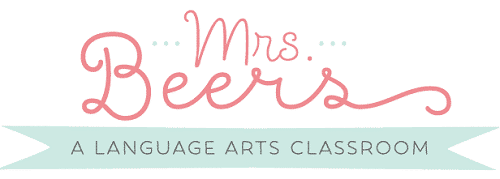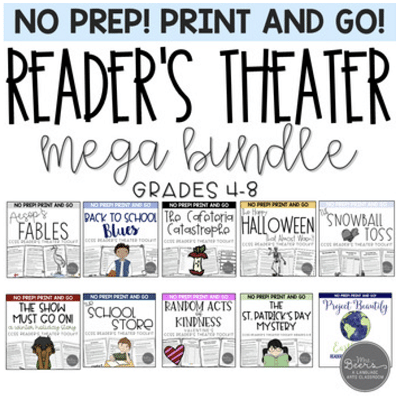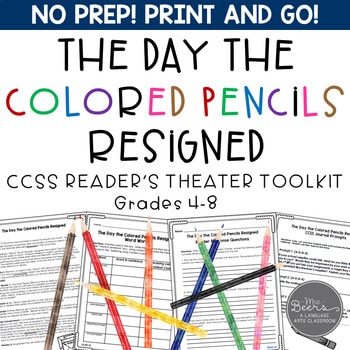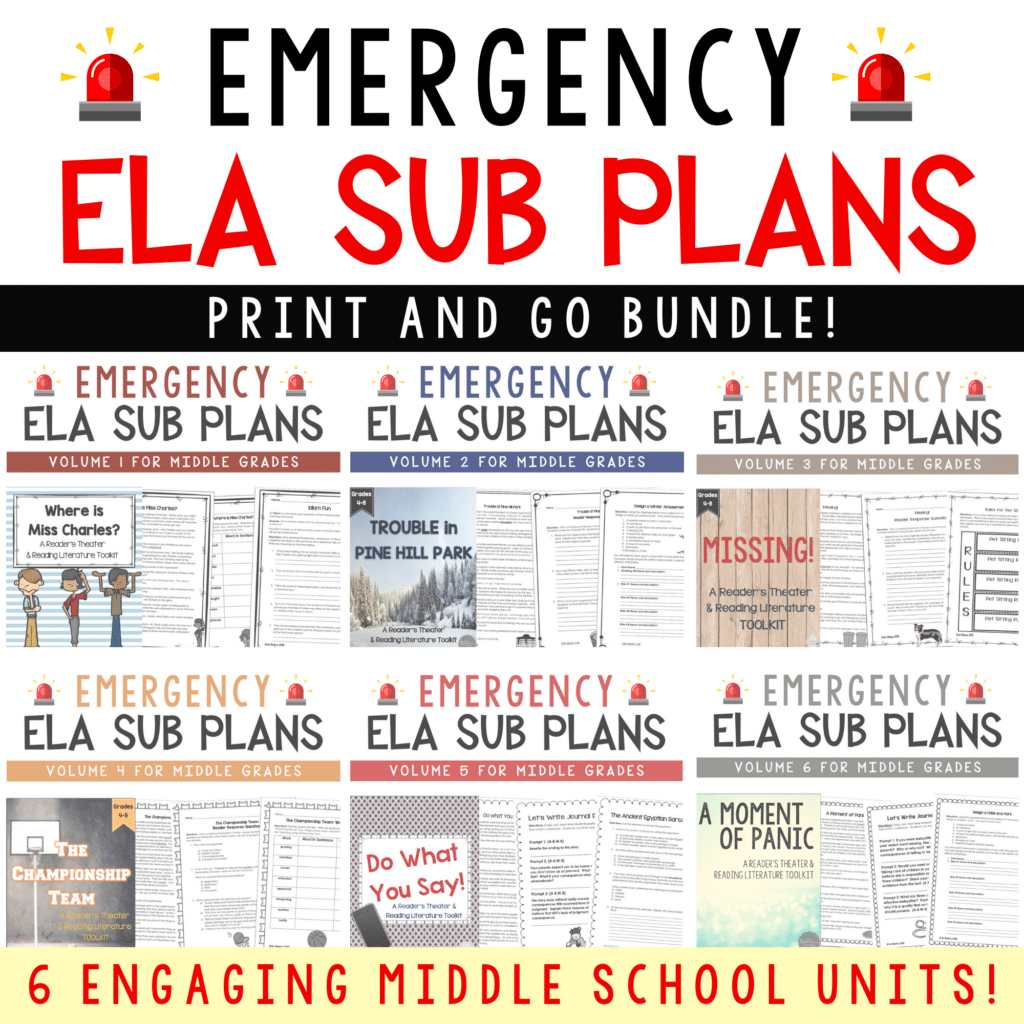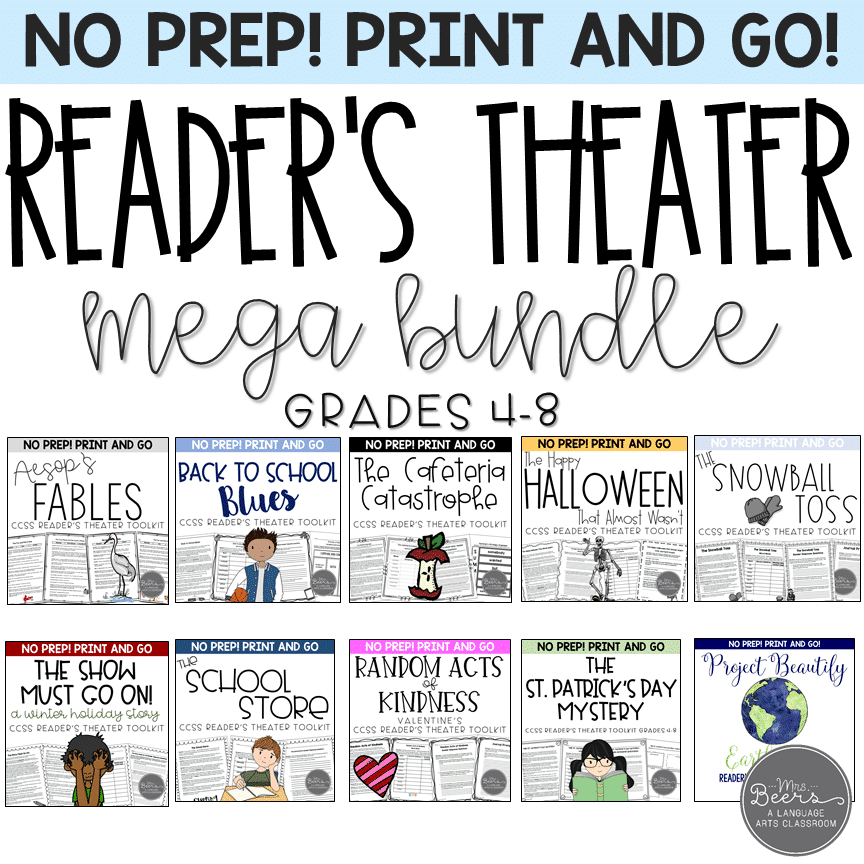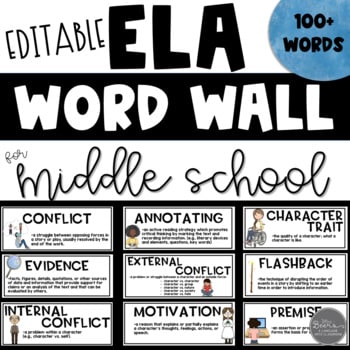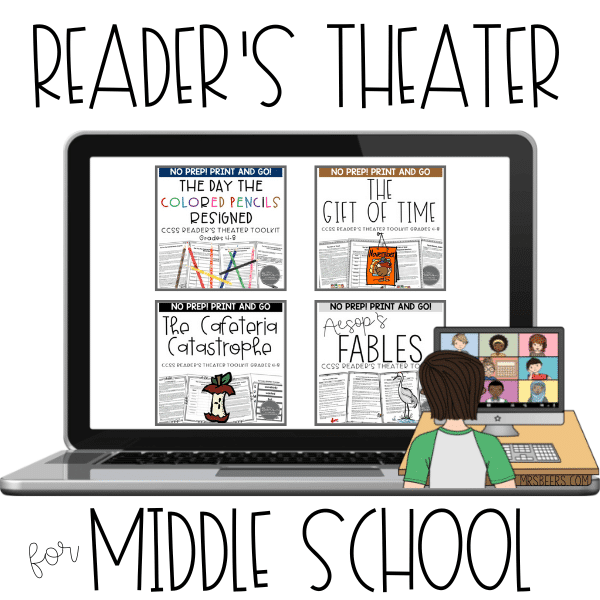
While I love a good read aloud so that my students have the opportunity to hear fluent reading, I also want my students to work on fluent projection and inflection. As teachers, we need to create scenarios to hear our students read. These are some of the reasons I love using reader’s theater scripts for middle school language arts. Students always enjoy “performing” the stories, and each script provides opportunities to incorporate word work, journal writing, and reading comprehension activities.
I have created several reader’s theater scripts for my teacher toolbox to help my students practice their skills. The key to an engaging script is offering a story they can relate to as “big kids” in middle school. This was my goal in creating the different resources featured below. The majority of these scripts have between 10 and 12 speaking parts and take 20 to 30 minutes to read aloud.
WHERE TO START
If you are new to reader’s theater, then I recommend trying The Cafeteria Catastrophe as an easy way to experiment with the concept. This printable PDF script features 11 characters and includes 3 different comprehension activities. Your students will be engaged throughout as they navigate the “drama” that unfolds in this fun storyline.
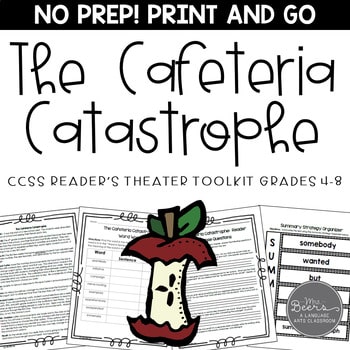
This is a popular script with 4th, 5th, and 6th grade teachers. The story is about a student who is planning to run for student body president of her school, but makes a bad choice by stealing from the school’s cafeteria. This results in a few undesirable consequences. Your middle grade readers will love the chance to transform into the characters and determine what happens to Clara. See full description on TPT.
Scripts for Every Season!
Reader’s theater is a fun way to incorporate the holidays and changing seasons while staying on task with your language arts lessons. The days leading up to a long weekend or holiday break can be challenging ones to keep students engaged. My reader’s theater bundle gives you a print-and-go script for every season in the school calendar!
The bundle includes 12 reader’s theater scripts for middle school, and each one is a separate PDF toolkit that includes word work and comprehension activities related to the story. The holidays covered in the bundle include Back to School, Halloween, Thanksgiving, Christmas, Valentine’s Day, St. Patrick’s Day, and Earth Day. In addition, there are 5 evergreen scripts that can be used throughout the year. Most teachers are using these in their 5th and 6th grade classrooms. See the full description on TPT.
Specialty Scripts for Middle Grades
Beyond seasonal themes, I have several specialized scripts to accompany a certain book or discussion topic that we cover during the year. Some of these were created specifically to bring more rigor to the read alouds I had done in the past.
Aesop’s Fables
If you are looking for a fun way to teach fables to your middle grade students, this Aesop’s Fables Reader’s Theater Toolkit has everything you need. Some schools introduce fable study as early as 3rd grade, but I’ve used this primarily with grades. 4-6.
Included in this resource are 4 scripts. Each is a single page, 3-character script with corresponding reader response questions. Your students will be able to work on fluency, enhance comprehension, and learn about the fable genre in a FUN way! The fables are The Fox and the Crane, The Fox and the Cat, The Wolf and the Crane, and The Town Mouse and the Country Mouse. See full description on TPT.
Strega Nona
Strega Nona is a great story to share with upper elementary students. It is a favorite of mine to read at the beginning of the school year in order to teach the importance of following directions. It is popular read aloud book that translates well to reader’s theater script.
This Strega Nona toolkit includes a 3-page, 5-character script with context clue word work, reader response questions, and journal prompts as comprehension activities at the end. Learn more about this resource on TPT.
The Day the Colored Pencils Resigned
One of my favorite read alouds is The Day the Crayons Quit by Drew Daywalt. I loved this book so much, I created my own even FUNNIER version to use with my students. You can have students read the original picture book and then compare and contrast similar texts with this unit.
This printable PDF script follows Brennan, who is a student who is putting minimal effort into his art project. His colored pencils take notice and decide that enough is enough; either he puts forth more effort and considers their suggestions, or they may not return. Your students will have a BLAST acting out this hilarious script. See full description on TPT.
The Tell-Tale Heart
The Tell-Tale Heart is a short story by Edgar Allen Poe that is usually a favorite with middle schoolers. My reader’s theater adaptation of this scary tale will get your students thinking more deeply as they take on the roles of the narrator, old man, and the police officer.
This is a fun script to use during Halloween or even Valentine’s Day to differentiate your lesson plans. While the 3-page, 3-character script is short, the discussion and literary analysis of this story is often engaging for students. The toolkit includes a context clue worksheet, multiple-choice reader response questions, extended response choice questions, and 3 journal prompts. See full description on TPT.
Common Core Standards
Each of my reader’s theater scripts and comprehension toolkits are designed to cover one or more of the Common Core standards below.
CCSS: 6-8 RL 1 Cite textual evidence to support analysis of what the text says explicitly as well as inferences drawn from the text.
CCSS: 6-8 RL 2 Determine a theme or central idea of a text and how it is conveyed through particular details; provide a summary of the text distinct from personal opinions or judgments.
CCSS: 6-8 RL 3 Describe how a particular story’s or drama’s plot unfolds in a series of episodes as well as how the characters respond or change as the plot moves toward a resolution.
CCSS: 6-8 RL 4 Determine the meaning of words and phrases as they are used in a text, including figurative and connotative meanings; analyze the impact of a specific word choice on meaning and tone.
CSS 6-8.W.4 Produce clear and coherent writing in which the development, organization, and style are appropriate to task, purpose, and audience.
Free Scripts to Download
Not sure if reader’s theater is a fit for your ELA classroom? Listed below are a few free scripts you can download to try with your students. The format of each is very similar to the PDF versions I have available in my TPT store. You can also join my email list below and you’ll get a free scripts to try after you sign up!
